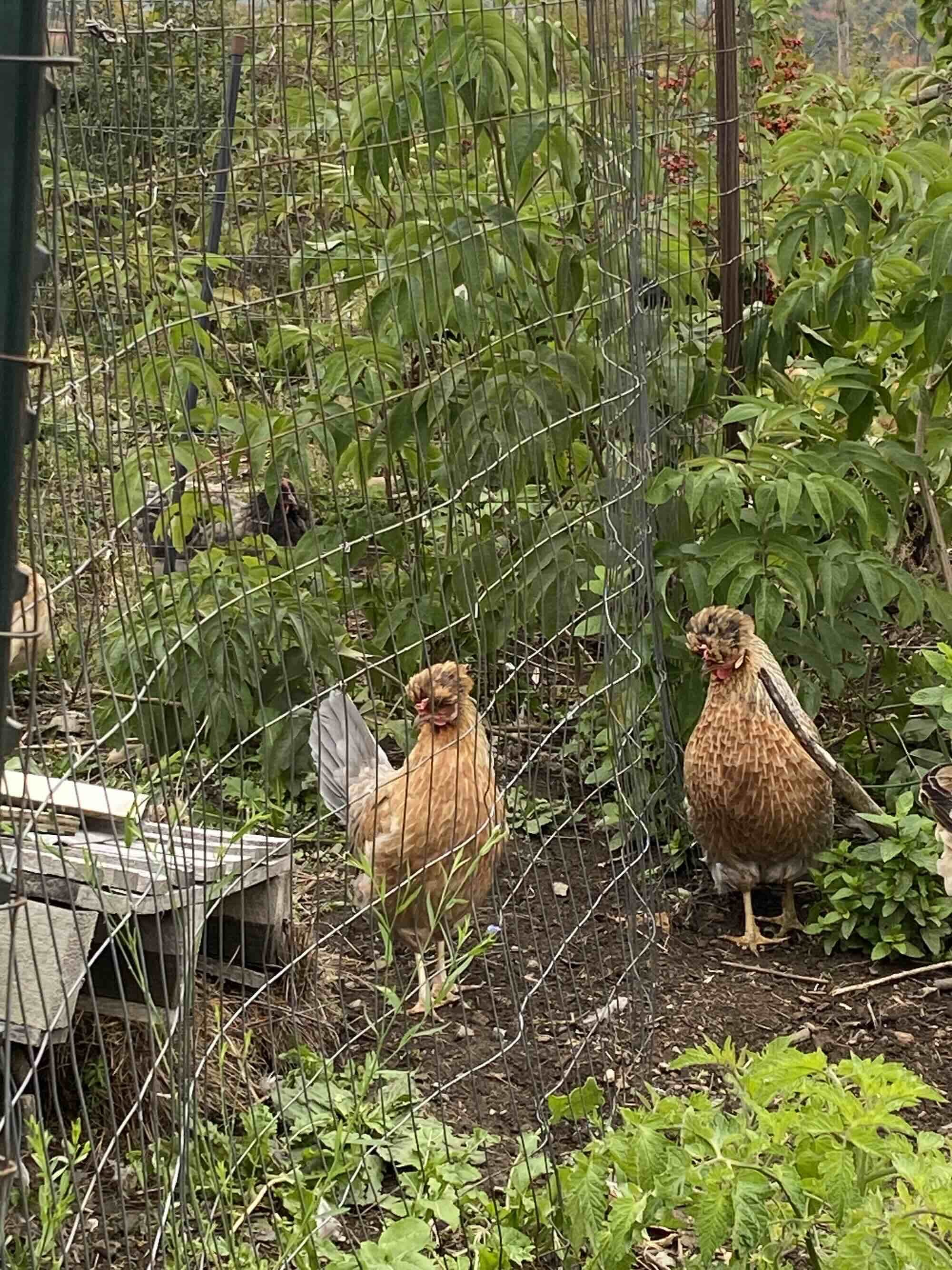Avian Updates
Apricot
Sixty-one. That’s how many chickens we’ve tended to and only 13 heartbeats currently beating. Since I last wrote, we have lost three more hens. Our eldest Apricot — our last connection to our original six chickens, the last to know Big Red. And then Creamsicle. And Rosie.
Creamsicle
A few posts ago, I wrote about the death of Rosie. Turns out that was the wrong bird. Embarrassing to admit, but true, it was Flopsie who died back in March and Rosie who took a turn for the worse this month, and then died. The vet said it was likely cancer for them both. My only excuse for my mix-up is that the two girls looked alike. Although Rosie’s giant spur and her rose comb were defining features, Flopsie’s comb — which wasn’t as tightly budded as Rosie’s — had so many feathers bedecking it that I could never quite tell them apart. Nothing new; mistakes are made here at Darwin’s View.
Rosie and Flopsie. Can you tell the difference?
Meantime, in mid-August, a crow with a broken wing was hopping about along the driveway. It was hot. I left a bowl of water and some chicken food, but it hopped frantically away. I didn’t see it again and figured nature had taken her course. But then Carl noted he had seen the bird, and then I saw Hoppy hopping.
For two weeks, Hoppy had hopped and fluttered, kept company by four fellow crows. Early on, I called a Bird Rescue. They suggested I “catch the bird, put it in a box and drive it” the hour to them. That wasn’t going to happen for a number of reasons. First, I know how stressful chasing a bird can be, having on occasion ended up hot, sweaty and disheveled attempting to catch a renegade chicken. The other myriad reasons fall under the category of how far I was willing to go to take care of this situation.
And so began the fantasies. I would befriend Hoppy, giving them shiny objects and food. Slowly Hoppy would make their way up the driveway and into the house where they would teach the cats not to get onto the counters. Hoppy would be safe through the winter, their wing would heal—I would have gently tweaked it to its right position—and they would fly off, happy and free in the spring.
I think we all know how likely it is that any of that would happen.
In reality, Hoppy appeared near the top of the driveway on a hot day. I left it a yogurt container of water, causing Hoppy to frantically hop away and the fellow crows to craw at me with disgust and censure. My worries renewed themselves. I called the rescue again. They repeated their suggestions with, I might add, the human equivalent of the crows’ disgust and censure.
“How does one catch a hopping crow?” I asked.
“With a net.”
“And then what? When I bring it to you, what happens?”
Long silence. A sigh.
“We examine it.”
“And. Will I be able to bring the bird home again? Will it be able to rejoin its friends?” Subtext: Am I merely stressing a wild bird only to have it put down?
Response: “How can I answer that without examining it? Likely as not it will have to stay here. It’s been 2 weeks? The wing is unlikely to be mendable at this point.”
We don’t own a net. But our farmer friends Elizabeth and Jim do. I called them and they offered to come over and help catch the bird.
But will that freak out the bird? And what if they just kill Hoppy at the rescue center? Maybe nature should be left to take her course. I mean, is it for me to interfere? Or am I being selfish, not gathering myself up boldly and going forth into the literal weeds to capture a bird that’s just minding its own business, if a bit lopsidedly?
Elizabeth and Jim and Carl all commiserated. At what point do we humans draw the line? It’s different for everyone, right? Some would have scooped up that bird the first day and high-tailed it to the rescue place where the bird would have met its fate.
Elizabeth used to volunteer at a place that would save small animals on occasion. Squirrels. Baby squirrels who were pushed ruthlessly out of the nest by a horrible Mother Squirrel. The humans would delicately tend to the baby squirrel. Bottle feed it until it grew up, straggly but alive! And unable to eat. What its mother had known, but the humans hadn’t, the now-adolescent squirrel’s teeth were offset in such a way… and so it would die.
Mother Nature knows best.
Elizabeth noted that if they did come over to help catch the bird with the net, they would never be able to come over to my house again because the fellow crows would forever-after dive bomb and attack them. That would go for me, too. Crows are smart. They take no guff from humans, or hawks for that matter; our crows are our chickens’ protectors.
At one point, a few days later, I noted a crow taking flight in a haphazard, tilted way. And Carl commented that he had noticed a bird practicing taking off. And so I hope and trust—since there is no sign of Hoppy—that Hoppy is now a happy bird, free and flying with its fellow avians, watching over our flock by teasing and tricking the passing hawks and owls.


